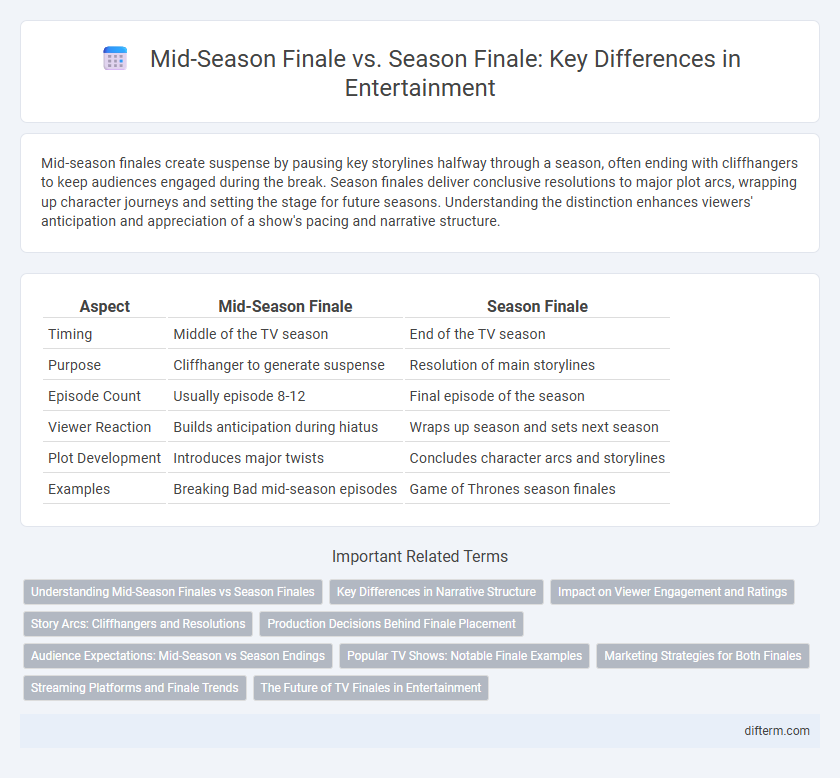Mid-season finales create suspense by pausing key storylines halfway through a season, often ending with cliffhangers to keep audiences engaged during the break. Season finales deliver conclusive resolutions to major plot arcs, wrapping up character journeys and setting the stage for future seasons. Understanding the distinction enhances viewers' anticipation and appreciation of a show's pacing and narrative structure.
Table of Comparison
| Aspect | Mid-Season Finale | Season Finale |
|---|---|---|
| Timing | Middle of the TV season | End of the TV season |
| Purpose | Cliffhanger to generate suspense | Resolution of main storylines |
| Episode Count | Usually episode 8-12 | Final episode of the season |
| Viewer Reaction | Builds anticipation during hiatus | Wraps up season and sets next season |
| Plot Development | Introduces major twists | Concludes character arcs and storylines |
| Examples | Breaking Bad mid-season episodes | Game of Thrones season finales |
Understanding Mid-Season Finales vs Season Finales
Mid-season finales serve as strategic narrative pauses that build suspense and often introduce major plot twists, designed to keep audiences engaged during a show's mid-year break. Season finales provide conclusive story arcs resolving key conflicts and character developments, setting the stage for the subsequent season's storyline. Understanding these differences helps viewers anticipate pacing and emotional payoff within TV series structures.
Key Differences in Narrative Structure
The mid-season finale typically features a significant plot twist or cliffhanger designed to maintain viewer interest during the show's break, while the season finale often resolves major story arcs and provides closure or sets up the next season. Mid-season finales usually focus on escalating tension and complexity within the narrative structure, whereas season finales emphasize resolution and character development. The pacing in mid-season finales is often faster with unresolved conflicts, contrasting the conclusive and reflective tone common in season finales.
Impact on Viewer Engagement and Ratings
Mid-season finales often boost viewer engagement by creating cliffhangers that sustain interest during hiatuses, leading to higher social media interaction and anticipation. Season finales typically generate peak ratings as they conclude story arcs and set up future plotlines, maximizing audience retention and advertiser value. Both formats strategically influence viewer habits, but mid-season finales play a crucial role in maintaining steady engagement across the broadcast calendar.
Story Arcs: Cliffhangers and Resolutions
Mid-season finales frequently end with cliffhangers designed to maintain audience interest and build anticipation during the show's hiatus. Season finales typically provide resolutions to major story arcs but often introduce new plot threads or twists to set up the following season. Both finales strategically balance suspense and closure, impacting viewer engagement and narrative momentum in television series.
Production Decisions Behind Finale Placement
Production decisions behind mid-season finales versus season finales often hinge on audience retention strategies and network scheduling. Mid-season finales are strategically placed to create suspense and boost viewership during a show's hiatus, maximizing advertising revenue and maintaining fan engagement. Season finales typically conclude major story arcs, requiring more extensive production resources and promotional efforts to deliver a satisfying climax and set the stage for renewal announcements.
Audience Expectations: Mid-Season vs Season Endings
Audience expectations vary significantly between mid-season finales and season finales, with mid-season finales designed to create suspense and encourage viewers to return after a break, often ending on a cliffhanger or unresolved plotline. Season finales are expected to deliver major story resolutions, character arcs conclusions, and often set the stage for the next season, providing a more definitive payoff. Networks and showrunners meticulously craft these episodes to maximize viewer engagement and ratings tied to key broadcast windows.
Popular TV Shows: Notable Finale Examples
In popular TV shows, the mid-season finale often features cliffhangers or major plot twists designed to maintain audience interest during a break, exemplified by series like "The Walking Dead" and "Stranger Things." The season finale typically delivers resolution or significant narrative developments, as seen in "Game of Thrones" and "Breaking Bad," concluding key story arcs. Both finales serve strategic purposes in audience retention and storytelling, with mid-season finales creating suspense and season finales providing closure.
Marketing Strategies for Both Finales
Mid-season finales drive engagement and sustain viewer interest through cliffhangers and targeted social media campaigns that amplify anticipation during the show's break. Season finales capitalize on larger marketing budgets and cross-promotional events to maximize viewership and boost subscription renewals. Both strategies rely on exclusive previews, merchandise drops, and fan interaction to enhance brand loyalty and generate buzz within entertainment communities.
Streaming Platforms and Finale Trends
Streaming platforms increasingly favor mid-season finales to maintain viewer engagement by creating suspense, often releasing episodes in batches to maximize subscriber retention. Mid-season finales usually feature significant plot twists or cliffhangers, keeping audiences invested during hiatus periods, while season finales deliver conclusive story arcs that conclude the entire season's narrative. The trend reflects shifting consumption patterns, with streaming giants like Netflix, HBO Max, and Amazon Prime adopting strategic scheduling to balance binge-watching appeal and ongoing viewer anticipation.
The Future of TV Finales in Entertainment
Mid-season finales create suspense by pausing storylines mid-arc, keeping audiences engaged over breaks and boosting viewer retention metrics. Season finales provide resolution to key plot points, often culminating in cliffhangers or major twists that drive anticipation for the next season. The future of TV finales may merge these approaches with interactive and streaming platforms, offering dynamic, audience-driven conclusions that enhance engagement and redefine narrative pacing.
Mid-season finale vs season finale Infographic

 difterm.com
difterm.com